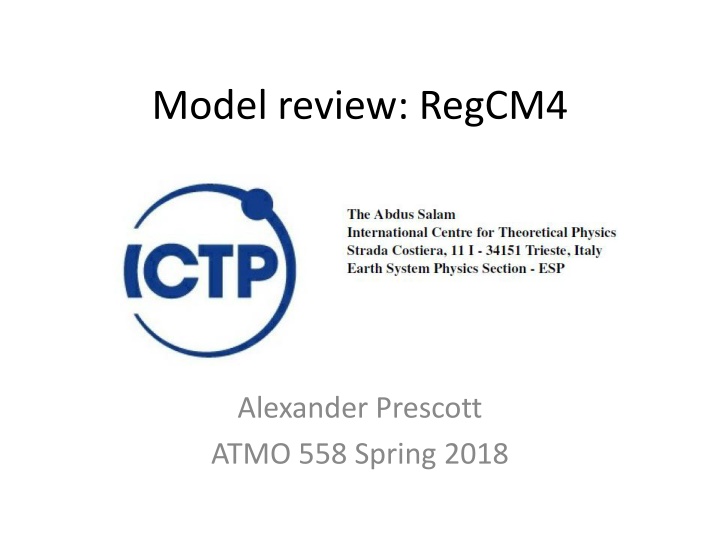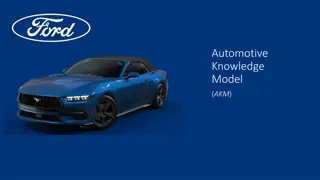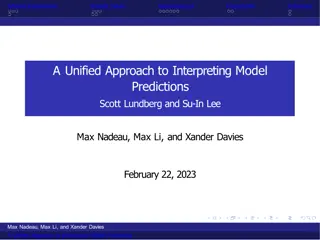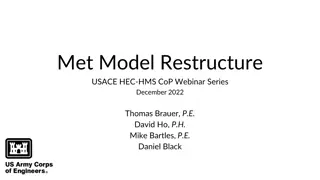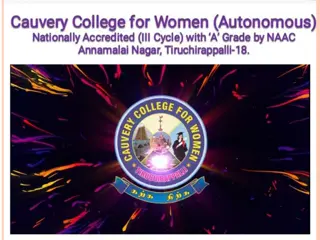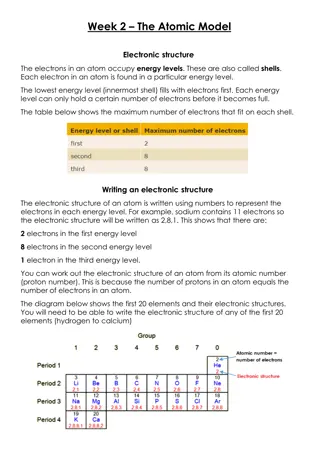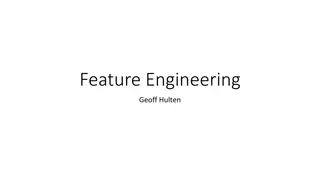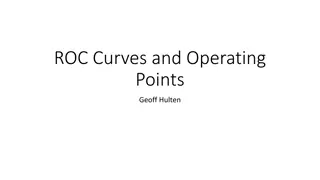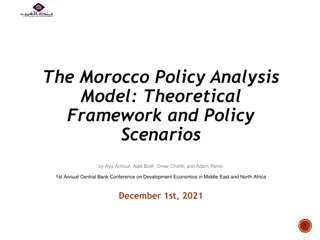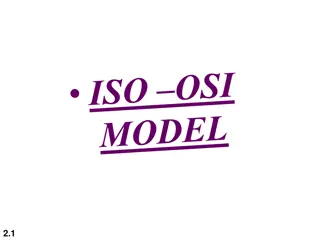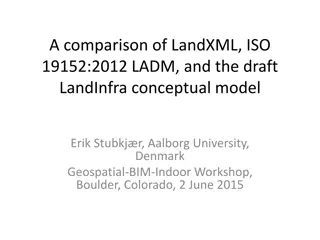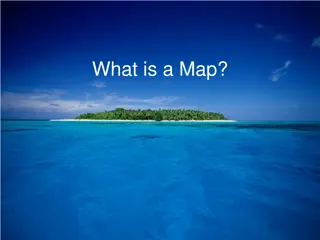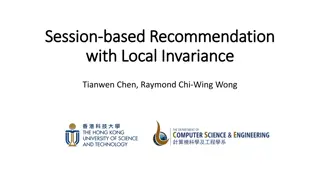Overview of RegCM4 Model Features
RegCM4 is a community model developed since the 1980s, with over 800 scientists contributing to its advancements. It features a fully compressible, rotating frame of reference and a limited area dynamical core based on the Penn State/NCAR Mesoscale Model 5 (MM5). The model uses hydrostatic and nonhydrostatic solvers, variable horizontal and vertical resolution, and solves primitive equations directly, among other functionalities. Its grid employs sigma coordinates, Arakawa B-grid, and Lambert conformal map projections. The model also accounts for hydrostatic horizontal momentum, pressure, and thermodynamics in its calculations.
Download Presentation

Please find below an Image/Link to download the presentation.
The content on the website is provided AS IS for your information and personal use only. It may not be sold, licensed, or shared on other websites without obtaining consent from the author.If you encounter any issues during the download, it is possible that the publisher has removed the file from their server.
You are allowed to download the files provided on this website for personal or commercial use, subject to the condition that they are used lawfully. All files are the property of their respective owners.
The content on the website is provided AS IS for your information and personal use only. It may not be sold, licensed, or shared on other websites without obtaining consent from the author.
E N D
Presentation Transcript
Model review: RegCM4 Alexander Prescott ATMO 558 Spring 2018
Background Developed since the 80 s Community model -- >800 scientists Fully compressible, rotating frame of reference, limited area Dynamical core: based on the Penn State / NCAR Mesoscale Model 5 (MM5) Hydrostatic and nonhydrostatic solvers Variable horizontal and vertical resolution Primitive equations Solve T and P directly Modified flux form
Model grid and map projections Sigma coordinates ? = ? ???? ???? ????= ? ???? ? Arakawa B-grid T,q,p at grid centers u,v,w at grid edges Lambert conformal map projection parameters ? =sin(?1) sin ? ? =sin ? ? cos? ? =? ?sin?1 Setting ? = 0 gives Mercator projection Setting ? = 1 gives polar stereographic projection tan 0.5? tan 0.5?1 uy ? tan 0.5? tan 0.5?1 +?? ? ?
Hydrostatic Horizontal Momentum: ? ? ? ?? = ?2? ? ?? ? ?? + ? ? ? 12 cos ? ? Advection PGF Coriolis ? ? ?? ?? ? ? ?? ?? ??+?? ??? ? +?? ? ?? + ? ? ? + ? + ?? ?? ? + ??+ ??? ? Coriolis (vertical) Diffusion ? ? ? ?? = ?2? ? ?? ? ? ?? ?? ? ? ?? ?? ??+?? ??? ? +?? ? ? ?? + ? ? ? + ? + ?? ?? ?? ? ? ? ? 12 cos ? +? + ??+ ??? ? Where ? is the vertical velocity in ?-coordinates (?? coriolis parameter, FHand FVrepresent horizontal and vertical diffusion. ??), ? is geopotential height, f is the
Hydrostatic Horizontal Momentum: ? ? ? ?? = ?2? ? ?? ? ?? ? ? ?? ?? ? ? ?? ?? ??+?? ??? ? +?? ? ?? + ? ?? + ?? ?? ? + ??+ ??? ? ? ? ?? = ?2? ? ?? ? ? ?? ?? ? ? ?? ?? ??+?? ??? ? +?? ? ? ?? + ? ?? + ?? ?? ?? ? + ??+ ???
Hydrostatic Pressure: ??= ?2? ? ? ? ? ? ?? ?? ? ?? ? ? + ?? ?? Used in vertically integrated form: 1 ? ? ? ? ? ? ?? ??= ?2 ? ? + ?? ?? ?? 0 Allows for solution of the vertical velocity in ?-coordinates: ? ? ? ? ? ? ??? ? = 1 ? ? ??+ ?2 ? + ?? ?? ?? 0
Hydrostatic Thermodynamics: = ?2? ? ?? Adiabatic Diabatic ? ? ?? ?? ? ?? ?? ? ? ?? +? ? ???? ? ? + + + (??+??)? ?? ? +?? ?? ?? ?? ? Where cp is spec. heat for moist air at constant p, Q is the diabatic heating, FH represents horizontal diffusion, FV represents vertical mixing and dry convective adjustment, and: ??= ? ? + ??? ?? ??=?? ??+ ? ??? ??+?? ? =?? ??; ?? Hydrostatic equation: ?? ??? ?? 1 + ?? = ?ln ? +?? 1 + ?
Non-hydrostatic Developed by Dudhia 1993 to overlap and be consistent with pre- existing hydrostatic model (MM1-4) Incorporation resulted in MM5 Define reference state with perturbation : ? ?,?,?,? = ?0? + ? (?,?,?,?) ? ?,?,?,? = ?0? + ? (?,?,?,?) ? ?,?,?,? = ?0? + ? (?,?,?,?) Vertical sigma coordinate: ? =?0 ?? ?? ?? where ps and pt are independent of time Total pressure at a grid point: ? = ? ? + ??+ ?
Non-Hydrostatic From Dudhia (1993), original derivation Non-acoustic terms Acoustic terms Equation (4): bouyancy split into 2-terms Acoustic: ? ? ? Non-acoustic: ??0 ? The non-acoustic terms correspond to ?? waves don t alter ? much ? ? ?0,??????? ??? ?0, as sound
Non-hydrostatic Local mass divergence Advection PGF Momentum ? ? ? Coriolis ?? = ?2? ? ?? ? ? ?? ?? ? ? ?? + ???? ?? ?? ?? ? ?? ?? ?? ?? ? ? + ? ?? ? ??cos? + ?? + ? ?? ?? ? ? ? ? ?? = ?2? ? ?? ? ? ?? ?? ? ? ?? + ???? ?? ?? ?? ? ?? ?? ?? ?? ? ? ? ?? + ? ??sin? + ?? + ? ?? ?? ? Liquid drag ? ? ? ?? = ?2? ? ?? ? ? ?? ?? ? ? ?? + ???? ? ??0 ?? ??+?? ? ?0? 1 ? ? ? ? ? ??+ ?? + ?? ?? ? ??0 + ? ? ?cos? ? sin? + ?? Where: ??? = ?2?? ? ?? ? +?? ? ?? ? ? + ?? ?? ??? ?? ?? ? = ?0? ? ? ?? ??? ?
Non-hydrostatic Pressure ? ? ? ?? ? ? ?? ? ? ?? ?? ? ? ?? ?? ? ?? ? ? = ?2 + ? ??? + ?? ?? ?? ?? ?? ?? ?? ?? ? ?? ??+ ? ?? ?? + ?0????? ? ?2? ?? ?? ?? ?? + ? ?0?? Temperature = ?2? ? ?? ? ? ?? ?? ? ?? ?? ? ? ?? ? ? + + ???? + ?? ?? ?? ?0?? ? ?? ] +? ? [? ?? 1 Adiabatic term + ?? ??? ??
Non-hydrostatic Sound waves handled through time-splitting, recursion following Klemp and Wilhelmson (1978); advection, diffusion, Coriolis and non- acoustic buoyancy terms collected in Sxand held constant: ?? ??+? ? ?? ??+? ? ?? ?? ?0 ? ? ?? ? ?? ?? ?? ?0?? = ?? ?? ?? ? ?? ?? ? ? ?? ?? ?? ?? ?? ?? ?? ?? ? ?= ?? = ?? ? = ?? ? ?? ??+? ?? ? ?? ??+ ?2?? ?? ?? ?? ? ?? ??+ ? ?? ?? ?0??? ?? ?? ? ?? ?? ?
Parameterizations Radiation scheme follows NCAR CCM3 Land Surface models: BATS (default), CLM Planetary boundary layer scheme Holstag PBL U. Washington turbulence closure model Convective precipitation Kuo scheme Grell scheme MIT-Emmanuel scheme Large-scale precipitation SUBEX New cloud microphysics ECMWF IFS Ocean flux Zeng scheme Prognostic SSTs Zeng scheme Lake model optional Aerosols and dust parameterizations
References Anthes, R.A., and T. T. Warner, 1978: Development of hydrodynamic models suitable for air pollution and other mesometeorological studies. Mon. Wea. Rev., 106, 1045-1078. Anthes, R.A., N. Seaman, J. Sobel and T. Warner, 1974: The development of mesoscale models suitable for air pollution studies. Select Group in Air Pollution Meteorology, Second Annual Report: Vol. 1, Environmental Protection Agency, Research Triangle Park, NC, 271 pp. Dudia, J., 1993: A nonhydrostatic version of the Penn State / NCAR mesoscale model: Validation tests and simulation of an Atlantic cyclone and cold front. Mon. Wea. Rev., 121, 1493-1513. Elguindi, N., X. Bi, F. G, et al., 2014: Regional Climate Model RegCM Reference Manual Version 4.5. International Centre for Theoretical Physics, Trieste, Italy, 37 pp. Grell, G. A., J. Dudhia, and D. R. Stauffer, 1994: Description of the fifth generation Penn State/NCAR Mesoscale Model (MM5), Tech. Rep. TN- 398+STR, NCAR, Boulder, Colorado, pp. 121.
